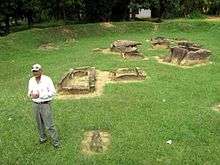Ibbankatuwa Megalithic Tombs

Ibbankatuwa Megalithic Tombs site (Sinhala: ඉබ්බන්කටුව මෙෙගලිතික සුසාන) is an ancient burial site located near Ibbankatuwa Wewa in Galewela DS, Sri Lanka.[1] The site is believed to be belongs to the megalithic prehistoric and protohistoric periods of Sri Lanka and considered as one of the several ancient burial sites that have been found in the country. The site is situated on the Kurunegala - Dambulla road approximately five kilometers before Dambulla town. Currently the tomb site has been designated as an archaeological protected site in Sri Lanka.[2]
Discovery and excavation
The prehistoric period of Sri Lanka ranges from 250,000 – 1,000 BC. The transition period between the end of the prehistoric period and the commencement of the historic period is known as the protohistoric period. The Ibbankatuwa tomb site was first identified in 1970[3] by the Archaeological Department who carried out the Radiocarbon dating of the remnants found in the site have revealed that these tombs dated back to 700 – 400 B.C. time periods.[4] After that a number of archaeological excavations were carried out in 1983–1984 and again between 1988 and 1990.[3]
Ancient Settlement
The ancient Ibbankatuwa settlement is located about 150 m (490 ft) southwest of Dambulu Oya river and approximately 200 m (660 ft) east of the eastern edge of the cemetery. The site is approximately 6 ha (15 acres) in size. The first excavation was done in 1988 and then in 1989, 1990 and 1991.[5]
Tombs
The tomb complex covers an area of about 1 km2 (0.39 sq mi) with 42 clusters of tombs[6] and each cluster contains about 10 tombs.[7] Each tombs are enclosed with four stone slabs and covered by another slab on the top.[1] According to the way of interment two distinct burial customs, urn (bodies were placed in urns and interred) and cist (ashes of deceased were interred) have been identified.
Cremated remains with grave goods and tools used by deceased have been found at the site in large terra-cotta urns and cists as well as in the area between the cists. The finds include variety of clay pots, iron, copper and gold artifacts, beads, necklaces, etc. The gemstones found in some necklaces are not naturally found in Sri Lanka which indicates that they may have been imported.[3]
References
- 1 2 "Not enough publicity for historic cemetery". Daily News (Sri Lanka). 17 December 2012. Retrieved 16 December 2016.
- ↑ Gazette 1625 & 23 October 2009, p. 6.
- 1 2 3 "Ibankatuwa [3] : Unearthing Sri Lanka's Past". Amazinglanka. Retrieved 16 December 2016.
- ↑ Alberto Pozzi (2013). MEGALITHISM. Sacred and Pagan Architecture in Prehistory. Florida: Boca Raton. p. 280.
- ↑ Priyantha Padmalal Karunaratne (2010). Secondary State Formation During the Early Iron Age on the Island of Sri Lanka... University of California, San Diego. p. 123.
- ↑ "New Tombs Discovered From Ibbankatuwa". Asianmirror. 17 October 2015. Retrieved 16 December 2016.
- ↑ "Prehistoric cemetery at Ibbankatuwa". Sunday Observer (Sri Lanka). 6 October 2013. Retrieved 16 December 2016.
Coordinates: 7°50′14.1″N 80°37′47.6″E / 7.837250°N 80.629889°E
External links